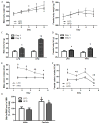Effects of energy status and diet on Bdnf expression in the ventromedial hypothalamus of male and female rats
- PMID: 24709620
- PMCID: PMC4041709
- DOI: 10.1016/j.physbeh.2014.03.028
Effects of energy status and diet on Bdnf expression in the ventromedial hypothalamus of male and female rats
Abstract
Sex differences exist in the regulation of energy homeostasis in response to calorie scarcity or excess. Brain-derived neurotrophic factor (BDNF) is one of the anorexigenic neuropeptides regulating energy homeostasis. Expression of Bdnf mRNA in the ventromedial nucleus of the hypothalamus (VMH) is closely associated with energy and reproductive status. We hypothesized that Bdnf expression in the VMH was differentially regulated by altered energy balance in male and female rats. Using dietary intervention, including fasting-induced negative energy status and high-fat diet (HFD) feeding-induced positive energy status, along with low-fat diet (LFD) feeding and HFD pair-feeding (HFD-PF), effects of diets and changes in energy status on VMH Bdnf expression were compared between male and female rats. Fasted males but not females had lower VMH Bdnf expression than their fed counterparts following 24-hour fasting, suggesting that fasted males reduced Bdnf expression to drive hyperphagia and body weight gain. Male HFD obese and HFD-PF non-obese rats had similarly reduced expression of Bdnf compared with LFD males, indicating that dampened Bdnf expression was associated with feeding a diet high in fat instead of increased adiposity. Decreased BDNF signaling during HFD feeding would increase a drive to eat and may contribute to diet-induced obesity in males. In contrast, VMH Bdnf expression was stably maintained in females when energy homeostasis was disturbed. These results suggest sex-distinct regulation of central Bdnf expression by diet and energy status.
Keywords: Dietary intervention; Estradiol; Glucose; High-fat diet; Leptin.
Copyright © 2014 Elsevier Inc. All rights reserved.
Figures




Similar articles
-
Energy-restricted pair-feeding normalizes low levels of brain-derived neurotrophic factor/tyrosine kinase B mRNA expression in the hippocampus, but not ventromedial hypothalamic nucleus, in diet-induced obese mice.Neuroscience. 2009 May 5;160(2):295-306. doi: 10.1016/j.neuroscience.2009.01.078. Epub 2009 Feb 13. Neuroscience. 2009. PMID: 19217934
-
Reduction of high-fat diet-induced obesity after chronic administration of brain-derived neurotrophic factor in the hypothalamic ventromedial nucleus.Neuroscience. 2011 Oct 27;194:36-52. doi: 10.1016/j.neuroscience.2011.07.079. Epub 2011 Aug 5. Neuroscience. 2011. PMID: 21856381 Free PMC article.
-
Diminished hypothalamic bdnf expression and impaired VMH function are associated with reduced SF-1 gene dosage.J Comp Neurol. 2006 Oct 10;498(5):637-48. doi: 10.1002/cne.21070. J Comp Neurol. 2006. PMID: 16917842
-
The rise, fall, and resurrection of the ventromedial hypothalamus in the regulation of feeding behavior and body weight.Physiol Behav. 2006 Feb 28;87(2):221-44. doi: 10.1016/j.physbeh.2005.10.007. Epub 2006 Jan 18. Physiol Behav. 2006. PMID: 16412483 Review.
-
Fatty acid-induced astrocyte ketone production and the control of food intake.Am J Physiol Regul Integr Comp Physiol. 2016 Jun 1;310(11):R1186-92. doi: 10.1152/ajpregu.00113.2016. Epub 2016 Apr 27. Am J Physiol Regul Integr Comp Physiol. 2016. PMID: 27122369 Free PMC article. Review.
Cited by
-
Role of Adiponectin and Brain Derived Neurotrophic Factor in Metabolic Regulation Involved in Adiposity and Body Fat Browning.J Clin Med. 2020 Dec 26;10(1):56. doi: 10.3390/jcm10010056. J Clin Med. 2020. PMID: 33375318 Free PMC article.
-
Ondansetron ameliorates depression associated with obesity in high-fat diet fed experimental mice: An investigation-based on the behavioral, biochemical, and molecular approach.Indian J Pharmacol. 2017 Jul-Aug;49(4):290-296. doi: 10.4103/ijp.IJP_805_16. Indian J Pharmacol. 2017. PMID: 29326489 Free PMC article.
-
Sex Differences in the Association of HOMA-IR Index and BDNF in Han Chinese Patients With Chronic Schizophrenia.Front Psychiatry. 2021 Jun 21;12:656230. doi: 10.3389/fpsyt.2021.656230. eCollection 2021. Front Psychiatry. 2021. PMID: 34234699 Free PMC article.
-
Sex differences in brain-derived neurotrophic factor signaling and functions.J Neurosci Res. 2017 Jan 2;95(1-2):328-335. doi: 10.1002/jnr.23863. J Neurosci Res. 2017. PMID: 27870419 Free PMC article. Review.
-
Chronic Ultrasound Prenatal Stress Altered the Brain's Neurochemical Systems in Newborn Rats.Neural Plast. 2024 Feb 13;2024:3829941. doi: 10.1155/2024/3829941. eCollection 2024. Neural Plast. 2024. PMID: 39290524 Free PMC article.
References
-
- Morton GJ, Cummings DE, Baskin DG, Barsh GS, Schwartz MW. Central nervous system control of food intake and body weight. Nature. 2006;443:289–95. - PubMed
-
- Kawamoto Y, Nakamura S, Nakano S, Oka N, Akiguchi I, Kimura J. Immunohistochemical localization of brain-derived neurotrophic factor in adult rat brain. Neuroscience. 1996;74:1209–26. - PubMed
-
- King BM. The rise, fall, and resurrection of the ventromedial hypothalamus in the regulation of feeding behavior and body weight. Physiol Behav. 2006;87:221–44. - PubMed
Publication types
MeSH terms
Substances
Grants and funding
LinkOut - more resources
Full Text Sources
Other Literature Sources

